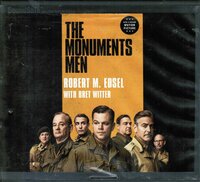Take a photo of a barcode or cover
615 reviews for:
The Monuments Men: Allied Heroes, Nazi Thieves, and the Greatest Treasure Hunt in History
Robert M. Edsel
615 reviews for:
The Monuments Men: Allied Heroes, Nazi Thieves, and the Greatest Treasure Hunt in History
Robert M. Edsel
informative
reflective
tense
slow-paced
I made it to page 235 before I had to admit defeat. I really wanted to like this book but this was one of the slowest storiesI've ever picked up. This was the one in a million case where the movie was actually better than the book.
challenging
informative
slow-paced
I am embarrassed at how long it took me to read this book. A fascinating story of a part of history that I had absolutely no clue about. I am glad that I read it, but I really struggled to finish for no other reason than my own mental blockage of reading non-fiction. Ultimately I learned that I enjoy looking at art more than I enjoy reading about it. One thing that bothered me was at the end of the book there were all these photos that correlated to parts of the story and I wish they would have been interspersed instead of just in a row at the end. Not sure if this is because I read this on a kindle or not but those photos were great and really conveyed the devastation and scope of the work these men did, and would have been so much more impactful if placed into the story where they fit in.
I loved this book! Normally I'm not huge into nonfiction, but I absolutely loved how the author portrayed the information as a story! The writing was amazing and truly captivated me on the work that these men and women did! The book is about Monuments Men (and a woman in France) who were assigned to the MFAA division of the army, in order to save the culture of Europe! Through the book, they go on the biggest treasure hunt the world has ever seen! Hitler was a rejected artist, and wanted to build and art museum in his hometown of Linz! So he began stealing art from all across Europe, and the monuments men had to find the art and bring it back to the rightful nations! The author told these people's stories with elegance, and I was intrigued the whole book! If you are hesitant to read nonfiction, but love historical fiction and art history, I would highly recommend this book
Remarkable story - repetitive at times, but well-told and the bravery and commitment of so many men and women is evident on the walls of our museums. It's sad to think about the art that was lost forever due to war, but heartening to read of the courage - and sacrifice - of the monuments men and women to our cultural heritage.
I meant to see this before the movie, but that didn't happen. After the movie less than lived up to expectations, I wasn't sure that I even wanted to read this. But I'm really glad that I did.
Sometimes after hearing the word "Nazi" thrown around as shorthand for a evildoers of all kinds you almost lose track of horrible they really were. This book really brings that point home, if organized mass murder and world domination weren't enough for you, they are also lying, cheating and stealing artwork and cultures out from anyone they thought was "unworthy of it."
I think the book is more able to capture the tension and struggle of the work the Monuments Men were doing. It also places them in a better context, obviously human life is more important then artwork or buildings, but they were there to be a voice for the culture after the conflicts had happened. There was a line that particularly struck me, it's one thing to protect the culture of your allies, it's another to fight for and try to protect the culture of your enemies, and then to give that culture back to them. It's also something, as Edsel points out at the end of the book, that has largely been missing in Global Conflicts since WW2. One could argue of course about the Western vs. Eastern culture hierarchy that is probably in part bound up in that decision, but it's worth noting. Even though I knew how some of this turned out, I found it suspenseful. A worthwhile read.
“The Monuments Men” by Robert Edsel is the amazingly true story of the Monuments, Fine Arts, and Archives division that was established during World War II. While Hitler and his Nazis were looting their way across Europe, these were the men and women who were in charge of preserving and recovering some of the most valuable works of art known to man. Without the efforts of the MFAA many monuments, cathedrals, paintings, tapestries, and sculptures would either be severely damaged or no longer exist. The Monuments Men were spread thin, but they covered an astounding number of miles and truly believed in their work. George Stout, James Rorimer, Robert Posey, Ronald Balfour, and Walker Hancock were just a few of the men who put their lives on hold to do some of the most important work that nobody seems to really know about.
Since “The Monuments Men” became a movie, this story is a lot more well known. Full disclosure, I have not seen the movie, though I do plan to at some point. The book, at least, was amazing. I checked this book out because I had decided to start reading more “grown up” books and this one immediately caught my eye. From what I understand, the movie brings all of the Monuments Men together to do some kind of grand heist…I’m not really sure. What I do know is that most of these men were the only member of the MFAA division in their section of the war effort and that other soldiers were not always cooperative in the Monument effort.
Something I hadn’t realized before reading this book was how old these men were. Most of them were approaching or already in their 40s! Joining the war effort was not something that was easy for most of them physically. In addition, these men were–for the most part–academics. They knew about art, not war. They were typically not military men turned MFAA officers but instead were museum men turned soldiers.
This book is magnificent. I cannot praise it enough. I learned a lot about WWII that I hadn’t known before and I felt that the author had a really good sense of what each of the Monuments Men must have been thinking during specific experiences. He obviously did extensive research to write this book and it shows. The book flows really well and I liked that we were able to spend time with a variety of the MFAA officers. I wholeheartedly recommend this book to anyone. You don’t have to be interested in World War II or architecture and art to appreciate this book–it’s simply a fascinating read.
Overall Rating: 5
Violence: Heavy. The Monuments Men themselves don’t do much fighting, but it’s a war and there are some graphic descriptions of the internment camp conditions.
Sexual Content: Mild. Talk of mistresses and prostitutes.
Language: Moderate. Soldiers and such.
Smoking/Drinking: Mild. Not a focus.
Since “The Monuments Men” became a movie, this story is a lot more well known. Full disclosure, I have not seen the movie, though I do plan to at some point. The book, at least, was amazing. I checked this book out because I had decided to start reading more “grown up” books and this one immediately caught my eye. From what I understand, the movie brings all of the Monuments Men together to do some kind of grand heist…I’m not really sure. What I do know is that most of these men were the only member of the MFAA division in their section of the war effort and that other soldiers were not always cooperative in the Monument effort.
Something I hadn’t realized before reading this book was how old these men were. Most of them were approaching or already in their 40s! Joining the war effort was not something that was easy for most of them physically. In addition, these men were–for the most part–academics. They knew about art, not war. They were typically not military men turned MFAA officers but instead were museum men turned soldiers.
This book is magnificent. I cannot praise it enough. I learned a lot about WWII that I hadn’t known before and I felt that the author had a really good sense of what each of the Monuments Men must have been thinking during specific experiences. He obviously did extensive research to write this book and it shows. The book flows really well and I liked that we were able to spend time with a variety of the MFAA officers. I wholeheartedly recommend this book to anyone. You don’t have to be interested in World War II or architecture and art to appreciate this book–it’s simply a fascinating read.
Overall Rating: 5
Violence: Heavy. The Monuments Men themselves don’t do much fighting, but it’s a war and there are some graphic descriptions of the internment camp conditions.
Sexual Content: Mild. Talk of mistresses and prostitutes.
Language: Moderate. Soldiers and such.
Smoking/Drinking: Mild. Not a focus.
I really liked this look into a very esoteric field in the army. Like the ending said, it seems like no other war turned into people being dedicated to reclaim art from the enemy. It was a very in-depth look at the evolution of the division, with the growing pains to eventual obscurity.






